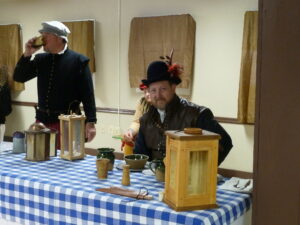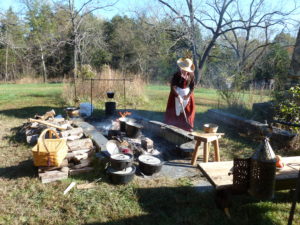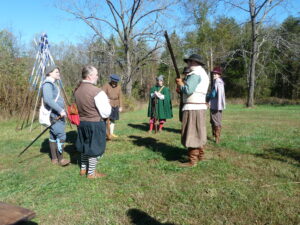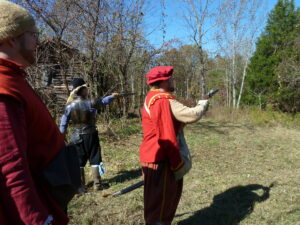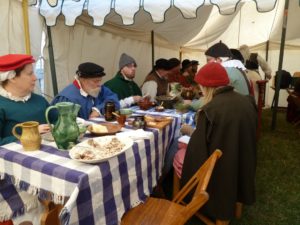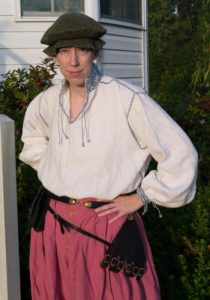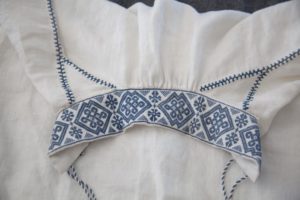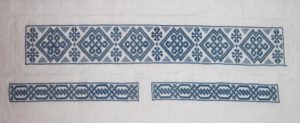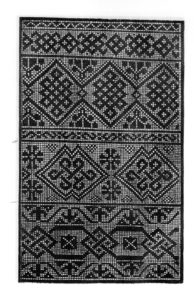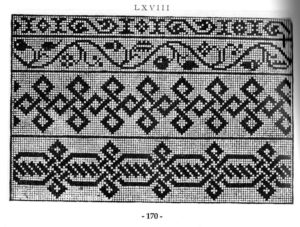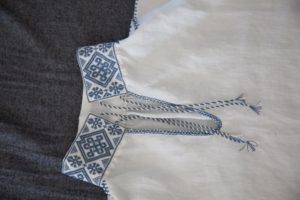Fingerloop Braiding for my Sweete Bag
2-1-14 Casa Mellin – The sweet bag continues to come along slowly. I am in the final stages working on the trimmings. Today I worked on the drawstrings and handle. The width of my bag is 5.5″, an average width on sweet bags I surveyed from the V&A. So a drawstring is normally twice this width with a couple of extra inches. I targeted my drawstrings to be a finished length of around 15″. The handle varied in length but according to Jacqui Carey’s survey of bags for her book, “Sweet Bags”, quotes 60cm or about 23.5 inches to be an average length.
Fingerweaving was a technique used to make purse strings and lacings in period. There are dozens of patterns created by this technique involving one or more workers. The handle and drawstring braid patterns typically match in period examples. Braids are created using all silk or a combination of silk and silver or gold passing threads. I chose a common pattern that had metallic passing threads in a chain pattern with silk border. This is referred as a French string in a 17th century pattern book written by Lady Cecilia Bindloss Standish.
The French string pattern actually involves 3 workers with 10 bowes of silk and 2 of silver or gold passing thread. The pattern I used is referenced as the Grene Dorge from an early 15th century manuscript translated by Lois Swales in “Purse Strings and Lacing Points”. This pattern is made from 6 bowes, 4 of one color and 2 bowes of two other colors and can be done by one worker. If you substitute the 2 other colors for metallic threads of one color you get the French string look. This is the pattern referenced in “Seventeenth-Century Women’s Dress Patterns: Book Two” on page 141 that surveys a sweet bag from the V&A.
To determine the length of bowes needed, take the final length you want then add 1/3 to it. Take this and double that for the length of silk or metallic thread used. I added another 2 inches since there is wastage at each end. I need two drawstrings about 15″ long and a handle about 24″ long. So my calculations to determine the length of each string is below.
15 x 1 1/3 = 20 x 2 = 40 + 2 = 42″ – drawstrings
24 x 1 1/3 = 32 x 2 = 64 + 2 = 66″ – handle
Here is a link from a great site managed by Zoe Kuhn and Lois Swales with directions for the braid I did.
http://fingerloop.org/patterns.html#n06
If you own Seventeenth-Century Women’s Dress Patterns Book 2, page 141 has directions as well.
References:
Carey, Jacqui. Sweet Bags:An Investigation into 16th & 17th Century Needlework. Devon, UK:Carey Company, 2009.
North, Susan & Tiramani, Jenny. Seventeenth-Century Women’s Dress Patterns, Book Two. New York:Harry N. Abrams Inc., 2012.
Swales, Lois. Purse Strings and Lacing Points: Instructions from an Early Fifteenth Century Manuscript. Not published, 1997.


